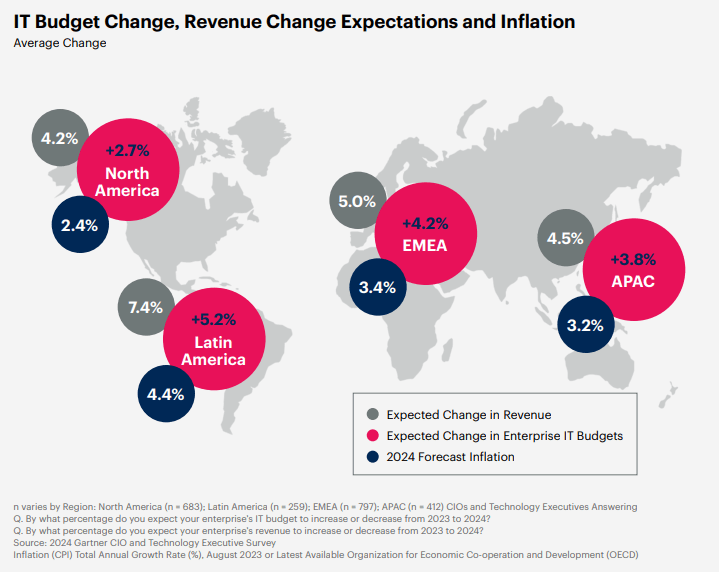Introduction to the 2024 Gartner CIO Agenda Report
In 2024, Chief Information Officers (CIOs) worldwide combat challenges in the economic and technological landscape. According to the Gartner 2024 CIO and Technology Executive Survey, CIOs of all regions expect IT budgets to increase at just 2.4% to 5.2%, barely above the projected inflation rates of 2.4% to 7.4% but very far below the expected revenue growth rates. This looks like a tightening landscape that compels the CIOs to deliver more capabilities and business value with restrained budgets, driving an intensified need for greater efficiency and innovation from IT.
Technologically, the landscape is changing with blinding speed. Digital transformation is still top on the agenda. Still, more so, there is a tremendous focus on the need for hard-core business outcomes from investments in new technologies like Artificial Intelligence, Data Analytics, and Cloud Computing. Thus, keeping up with the pace of technological changes, leading them, and integrating them into the core business strategy has become a huge focus for CIOs this year.
The 2024 Gartner CIO Agenda report highlights a strategy for CIOs to maximize the impact of their technology investments among budgetary and talent constraints. It mentions adopting a “franchise model” of digital delivery. The Report garnered insights from 2,457 CIOs and technology leaders across 84 countries, revealing critical data about IT management and strategy worldwide.
CIO Budget vs Revenue Expectations in 2024
CIOs face a daunting challenge in 2024—expected IT budget increases are only marginally higher than projected inflation rates across regions. North American CIOs expect a 4.5% increase in IT budgets against 3.4% inflation. In EMEA, the figures are 4.2% and 5.0% respectively. Latin American IT leaders project 5.2% budget growth versus 7.4% inflation. APAC projects a 3.8% budget increase against 4.2% inflation.
 Enterprises forecast far stronger revenue growth expectations that considerably outpace the modest IT budget expansions. This gap between budget and revenue growth will heighten pressures on CIOs to squeeze all possible costs and maximum business value from technology investments.
Enterprises forecast far stronger revenue growth expectations that considerably outpace the modest IT budget expansions. This gap between budget and revenue growth will heighten pressures on CIOs to squeeze all possible costs and maximum business value from technology investments.
The economic conditions set an efficiency imperative. CIOs must focus on doing more with less, delivering innovation and digital capability to topline growth while constraining operating expenses. These are smarter ways to fund, resource, and execute technology initiatives that can help bridge the budget-revenue gap in 2024.

Pillar 1: Co-Lead
This pillar signifies the collaborative approach to digital leadership, where the CIOs and the other executives work together to drive digital initiatives. It shows that the CIO should empower business leaders to be active in their daily tasks in digital transformation efforts and, therefore, share responsibility for success.
Pillar 2: Co-Deliver
This pillar emphasizes the need for CIOs to build trust and transparency among executives, business teams, and other executives to foster shared accountability. Trust is built through meaningful engagement and collaboration.
Organizations should establish fusion teams comprising IT and business team members to allow this collaboration. Access should be streamlined so that the collaboration can easily access the needed tools and technology platforms.
Pillar 3: Co-Govern
Pillar three underscores the significance of good governance in managing compliance and mitigating risks within a franchise model for digital delivery. The orchestration approach has to team up with the CxO peers to mitigate risk in equilibrium and balance this with the benefits of franchising.
This will be important in overcoming coordination problems and a lack of standards through CoPs, and they have also served as feedback channels to update governance policies and standards.
CoP Implementation will be successful if IT and business leaders collaborate to engage active technologists. Community members will define objectives, while IT strategies will primarily aim at secure development practices.
Appointment of community leaders facilitates coordination and support, while common metrics can enable engagement measurement across CoPs, not just the outcome.
Conclusion
The franchise model of digital delivery offers a collaborative path forward for CIOs and their organizations. CIOs can foster a culture of shared responsibility and accountability by leveraging the three pillars of co-lead, co-deliver, and co-govern. This approach empowers business leaders, streamlines collaboration, and mitigates risks effectively. It signifies a strategic shift towards greater efficiency and innovation, essential for navigating the evolving technological landscape. As CIOs embark on this journey, they must engage CxO peers deliberately and transcend traditional IT boundaries to drive successful digital transformations.
FAQs
1. What are the main challenges CIOs are facing in 2024?
The Gartner CIO Agenda report for 2024 highlights that CIOs worldwide expect only marginal IT budget increases above projected inflation rates, well below the expected revenue increases for their enterprises. This means CIOs need to find ways to drive greater efficiency and deliver more with limited resources.
2. What is an IT budget?
IT budget aligns well with the organization’s business strategy. It is typically the money spent on an organization’s IT systems. CIOs or IT executives oversee it.
3. What is the franchised digital delivery model proposed in the report?
“Franchised” approach to digital delivery, co-leading digital initiatives with other C-suite executives (CxOs), co-delivering through fusion teams of IT and business personnel, and co-governing through communities of practice and embedded risk experts.
4. What are the three pillars of the franchised model?
The three pillars are:
1) Co-lead digital delivery with CxO peers,
2) Co-deliver through fusion teams of IT and business, and
3) Co-govern digital initiatives through communities of practice and risk management.
5. How can CIOs get other executives to co-lead digital initiatives?
The report suggests surfacing pain points that require business ownership, identifying franchise-minded CxOs, and intentionally engaging them in new, agile ways of working.
[To share your insights with us as part of editorial or sponsored content, please write to sghosh@martechseries.com]


